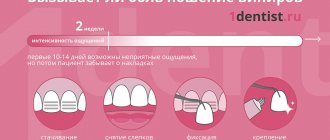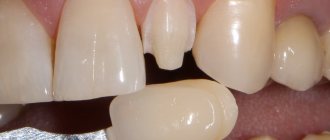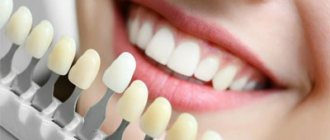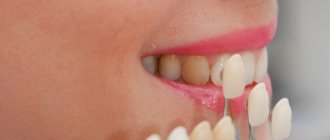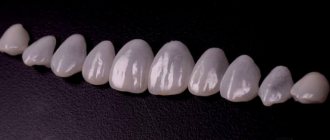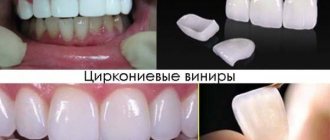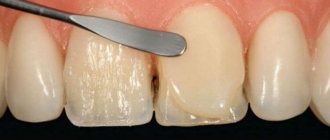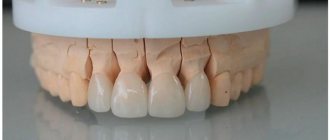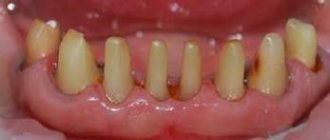Not all people can boast of perfect teeth, despite the fact that the standard of living is now much higher than in previous years and even centuries. Hereditary diseases, drug abuse, and injuries can sometimes cause problems and make smiles look unhealthy and unattractive.
But now such troubles can be dealt with with the help of veneers - thin plates that cover minor defects on the front of the teeth and correct their aesthetics. Installation of such overlays often requires preparation of the enamel, which does not seem like a wasteful action.
Benefits of veneers
All those shortcomings that dentists previously proposed to correct by installing crowns are now quite successfully masked with veneers. This:
- Cracks and chips in enamel;
- Darkening, spots;
- Areas with erosion of tooth enamel;
- Tetracycline teeth;
- Uneven cutting edges;
- A slight rotation of the tooth around the central axis, etc.
Emax veneers are considered the best aesthetic solution in microdental prosthetics. The surface of plates made of artificial material of natural origin reliably imitates the transparency, shine and color of human enamel, so those around them perceive the teeth as “native”.
Stage of digital modeling of veneers
To develop veneers, in some cases I use digital design in a special 3D program and, perhaps, one of the most interesting solutions for patients is Digital Smile Design
.
What's good about this solution? Thanks to digital technology, the patient can see his future smile with veneers on the computer screen and suggest adjustments if he doesn’t like something. That is, the patient has time to try on veneers online and see his future new smile from the outside. And when we approve the future design and color, only after that permanent veneers will go into production.
Digital modeling allows you to print a model on a 3D printer and use it to work out exactly the combination of veneers and their shapes that will completely suit the patient. Thanks to digital modeling, we recreated the correct anatomy of Korney’s teeth using digital virtual veneers, normalized the chewing load and got exactly the smile that suited him best
:
Why is preparation necessary?
Orthopedic treatment often requires the dentist to resort to grinding of the enamel. Such pre-treatment ensures the most durable attachment of the prosthesis to the surface of the tooth and its hermetically sealed coating. A few years ago, the procedure was painful and traumatic, which scared patients away and left bad memories. Nowadays, enamel preparation is performed using minimally invasive methods, using high-tech equipment, quickly and without experiencing painful sensations.
Nevertheless, patients continue to express concerns and ask whether this step can be avoided when installing veneers. However, in the vast majority of cases it is unlikely to be possible to completely avoid preparation. The reason is the high requirements for the quality of contact between the plate and the tooth. The surface of the enamel is never perfectly smooth; there are always microscopic tubercles, grooves, and depressions. If the veneer does not fit tightly, these cavities become the focus of bacterial masses.
In addition, the enamel is removed before the veneer is placed to reduce the final thickness of the tooth. When a plate is applied without preliminary preparation, the tooth will become larger and more massive, which will not beautify the smile and cause functional discomfort to the person.
The third reason for preparation will be a large amount of carious tissue. To eliminate the possibility of further damage to the tooth under the veneer shield, they will need to be removed.
But under some circumstances, when installing veneers, the dentist leaves the patient’s teeth intact.
Do you want to get professional advice on veneers?
8
or order a free call
Request a call
Temporary veneers
The process of installing veneers occurs according to the following scheme:
- First we make the upper jaw
. We process the teeth and install temporary veneers:
- then we install permanent veneers on the teeth of the upper jaw and prepare the teeth of the lower jaw
for temporary veneers:
Modeling a smile on a model
Before grinding the teeth, Korney's future smile was not only modeled in virtual reality, printed on a 3D printer, but also reproduced on plaster models:
When preparation for veneers is not necessary
Preparation of enamel is practically not required if a person has direct veneers made from composite mass. This is a special type of correction of the external surface, when the doctor layers a special material on the enamel. The procedure is performed in one clinic visit. However, composite veneers delivered without any treatment are still a rather rare case.
Ceramic veneers are made in a dental laboratory using a synthetic impression. Here it is important to tightly and firmly attach the plate to the tooth tissue, so grinding down the enamel is a necessity.
Exceptions to the rules when tooth preparation will only harm quality veneering:
- Visual correction of tooth rotation is assumed;
- Severe initial wear of the enamel;
- There are irregularities in the cutting edge of the tooth;
- The vestibular surface of the tooth requires thickening.
When installing any types of veneers - ceramics, porcelain, composite - you will have to remove the enamel if it is destroyed by caries. It is impossible to preserve the pathology under the veneer.
In exceptional cases, for example, when restoring a missing tooth wall, preparation as such is not performed. The doctor simply adds some roughness to the enamel so that the plate clings better to the surface being corrected.
Veneers without grinding – is this possible?
The need to prepare teeth before veneering depends to a greater extent on the indications and to a lesser extent on the type of restoration. Lumineers and their Russian analogue ultraneers have a minimum thickness. Therefore, there is no need for grinding before fixing them to the tooth. However, if the teeth are large and require correction of shape and size, preparation is indispensable. Thus, veneers without grinding can be placed for the following indications:
- Need for minor tooth discoloration.
- Elimination of gaps (diastemas) between the front teeth.
- Masking cracks in tooth enamel.
- The need to restore a chipped cutting edge of a front tooth.
The need to correct the shape of the teeth, add volume to them, as well as visually change the angle of their location or align the cutting edge will in any case require preliminary preparation.
What happens if you install an Emax veneer without grinding?
A doctor who cares about his own reputation will never agree to glue a veneer without preparation if he is absolutely sure that treatment is necessary. The patient should trust a qualified specialist to be satisfied with the result. Let's try to imagine what will happen if you put a veneer on a solid tooth in violation of the technology requirements:
- Significant darkening will remain visible even through the surface of the Emax veneer. Thin lumineers are especially translucent, so even when choosing these expensive porcelain onlays, turning is sometimes required.
- Despite the relatively small thickness of the ceramic plate, it still looks bulky on unprepared teeth: it adds volume, looks unnatural, and sometimes even interferes with articulation and chewing of food.
- A ledge often forms above the Emax veneer, near the gums, where plaque and bacteria accumulate. Pathogenic flora is also able to penetrate between the surface of the tooth and the plate itself. In such gaps it develops unhindered, causing caries and its complications.
Many patients are misled by advertising articles that say that it is possible to remove Emax veneers from unground enamel and thereby return the teeth to their natural appearance. This statement is erroneous, since veneers made from this material are relatively thick, and therefore always require paring, unlike ultra-thin veneers without grinding Luxneers and American lumineers (Lumineers).
Is it easy to install veneers?
In fact, fixing a veneer is a complete “re-equipment” of the tooth for it. Because a veneer is not a decorative sticker, but, in fact, something like artificial enamel. And in order to fix it for many years, the tooth is prepared in a special way - this is called preparation.
To summarize the essence of preparation, it is grinding down the top layer of enamel. And there are different technologies for how this is done - the dentist at the VivaDent clinic chooses a specific method based on the initial condition of the tooth and the reason for installing the veneer. But in any case, preparation is an irreversible procedure, after which the tooth is no longer called a tooth, but a stump - an onlay-veneer must be attached to it for the rest of its life.
Preparation methods
The latest methods of grinding down enamel to install artificial overlays involve gentle processing technology and high-precision equipment.
Laser method
A beam of polarized light acts on the hard tissues of the tooth. The moisture contained in them evaporates, and many hydraulic shocks occur, as a result of which the enamel is destroyed.
The advantages of the technique are the speed of impact, the absence of pain and the silent operation of the laser system. It is no secret that the buzzing of a drill is considered one of the most unpleasant auditory stimuli. There is no need for preliminary sanitation of the oral cavity, because the laser perfectly burns out all microflora in the treated areas.
It should be noted that working with a laser requires a steady hand and high qualifications from the dentist, and the professionalism of a specialist is usually well paid. In addition, laser treatment is superficial. If, for example, caries penetrates deep into the enamel, additional exposure will be required.
Ultrasonic treatment of enamel
Ultrasonic treatment of enamel also does not involve preliminary anesthesia - except in extreme cases, with tooth hypersensitivity. Under such exposure, tissues do not overheat and are not destroyed excessively - only within the required limits. Many doctors consider ultrasound as most appropriate in preparation for veneering.
Install veneers without grinding Luxneers teeth at Dr. Lopaeva’s clinic
Make an appointment
Or call +7(985)532-21-01
Chemical treatment of teeth
Preparation of enamel using this technology includes treating teeth with softening pastes. As a result, the outer tissue is easily removed. The disadvantage of this method is the duration of the procedure: the chemical composition requires time to act, approximately 30 minutes.
The advantages are significant:
- Painless;
- No overheating or thermal injury to tissues;
- The risk of excess enamel chipping and cracks is eliminated.
Tunnel preparation method
Grinding using this method will require the use of a special turbine unit. The doctor uses a multi-speed bur with a diamond tip. This treatment is used more often than others and allows for extremely precise control of the degree and depth of impact on the enamel.
The disadvantages of the procedure include pain (anesthesia is required) and increased requirements for equipment. The turbine greatly overheats the tooth tissue. If the device does not have a special cooling device, the patient will be injured. If you work carelessly with a bur, damage to soft tissues is possible - the dentist should not be distracted by anything while working.
Air abrasive method
This method is used only for treating the outer layers of tooth enamel and is used in combination with other methods. The principle of operation of a special installation is to influence the tooth with abrasive powder ejected under pressure. The enamel is removed painlessly and quickly. In this case, it is possible to avoid excessive heating of the organ tissues.
The choice of tooth preparation technology can be planned in advance during a consultation with a doctor. Not every clinic has the full range of equipment; the condition of the patient’s oral cavity and his individual reaction to the technique are also taken into account.
Clinical aspects of tooth preparation in the manufacture of porcelain veneers
The article is devoted to a practical issue - an algorithm is proposed for the use of abrasive tools in the manufacture of porcelain veneers (porcelain adhesive veneers, hereinafter FAO).
In a number of publications one can find judgments that preparation for veneers is a fairly simple manipulation that does not require significant skill. However, most experts, with whom we completely agree, consider this type of microprosthetics to be a very complex section of orthopedic treatment. Opponents of this point of view would like to object: “If it’s simple, then why such a price?”
Currently, the standards of basic dental education in the Russian Federation do not provide for the treatment of patients with defects in hard dental tissues with veneers. This leads to the fact that young specialists have a very vague understanding of the possibilities of this treatment method and only a few of them are able to qualitatively prepare a tooth for adhesive veneering. Most beginners, trying to impress their colleagues, “treat” patients, ultimately discrediting this type of microprosthetics. In our opinion, this is what leads to the fragility of these structures and prevents their wider use in everyday practice.
I would like to warn my colleagues against some incorrect approaches when treating patients using porcelain veneers. Considering that FAO is most often used to replace defects in the hard tissues of anterior teeth, a certain sequence should be observed. In other words, it is necessary to first replace existing defects in the lateral areas of the dentition, correct occlusal and articulatory relationships, taking into account the characteristics of the bite. It is important to take into account the presence of parafunctions of the masticatory muscles, somatic pathology, and in general all anamnestic data that allows orthopedic treatment with a long-term favorable prognosis.
Your view on the sequence of preparation and the peculiarities of working with abrasive instruments at the clinical stages of manufacturing FAO can be demonstrated using a clinical example of complex treatment of patient K., 55 years old. The primary clinical picture, the sequence of stages of preparation for orthopedic treatment and prosthetics are presented in Fig. 1–3.
Rice. 1. The dentition of patient K. at the stage of preparation for prosthetics.
Rice. 2. Orthopantomogram of the jaws after the manufacture of metal-ceramic crowns and a removable supported prosthesis on the lower jaw with a beam fixation system.
Rice. 3. Dentition after the end of the adaptation period and before the production of FAO for teeth 1.1, 2.1.
The production of veneers should begin only after replacing defects in the dentition and completing the period of adaptation to a removable denture.
As can be seen in Fig. 4, the maxillary central incisors have old composite veneers that do not meet clinical requirements. Unfortunately, dentists rarely encounter clinical situations where a veneer is made on a tooth that does not have any defects or old fillings. Therefore, for demonstration, we chose a rather complex clinical situation, and for clarity of manipulations, a similar tooth preparation was carried out on a phantom.
Rice. 4. Appearance of old direct composite veneers on 1.1, 2.1 teeth.
Anesthesia and opening of the periodontal groove with a retraction thread to ensure good access to the gingival area of preparation and quiet work of the doctor is a necessary condition (Fig. 5).
Rice. 5. Creation of marking grooves to control the depth of preparation of the vestibular surface.
The first stage is the preparation of the vestibular surface of the teeth with the creation of marking grooves that determine the volume of subsequent grinding. Considering that in the classic version, veneers are located within the enamel and their minimum thickness, which gives the porcelain mechanical strength, is 0.6–0.7 mm, marking bur 834-021M-FG is used, the design of the working part of which allows you to create grooves with a depth of 0. 5 mm (Fig. 5, 6).
Rice. 6. Marking grooves (view from the cutting edge).
It is better to apply the grooves in a vertical direction from the area located in the gingival part towards the cutting edge. This stage is important for determining the volume of tissue to be sanded and the thickness of the veneer being made.
The second stage is the formation of a gingival groove 0.5 mm wide and 0.5 mm deep (Fig. 7).
Rice. 7. Creation of a gingival groove with a depth and width of 0.5 mm.
This is conveniently done with a bur 868A-018M-FG with a rounded tip with a diameter of 1 mm, immersing it half the diameter into the hard tissues of the tooth. If you have confident manual skills, you can use burs 881-012С-FG or 882-012С-FG. The level of the groove depends on the condition of the enamel in this area. If the enamel is not destroyed or discolored, it is possible to create a groove up to the gingival margin. You should be very careful to create enough space for the porcelain lining. In other cases, the groove must be positioned more apically, but immersed no deeper than 0.5 mm into the periodontal groove. Insufficient preparation can lead to violations of the “biological width” of the gingival margin and the creation of a hypercontour of the restoration with subsequent negative reactions from the marginal periodontal margin (gingivitis, bleeding, recession).
Subsequent preparation of the vestibular surface can be carried out immediately along its entire plane with the simultaneous creation of grooves on the proximal edges, or first, approximal grooves are formed that connect to the gingival groove (Fig. 8–10)
Rice. 8. Creation of the approximal boundaries of the cavity and preparation of the vestibular surface of the bur.
Rice. 9. Depending on the height of the clinical crown, burs 881-012F-FG or 882-012F-FG are used.
Rice. 10. View of the treated surface from the side of the cutting edge.
Then the hard tooth tissues are ground down along the entire vestibular surface to the depth programmed by the depth marker.
Depending on the height of the clinical crown, burs with different lengths of the working part are used: 882-012F-FG, 881-012F-FG. It should be noted that in any case, when creating the approximal boundaries of the prepared cavity, they must be located as close as possible to the contact points. This allows you to make the edges of the veneer invisible and improve the aesthetics of the microprosthesis. If possible, interdental contacts should be maintained, but given that the edges of the veneer should not be very thin, in order to avoid chipping, the proximal grooves should have a depth of up to 0.5 mm. In some cases, it is necessary to open approximal (interdental) contacts. In our opinion, such preparation transforms the microprosthesis from veneers into the category of half-crowns. In this case, it is necessary to stabilize the teeth with temporary structures to prevent their displacement. In addition, this complicates the laboratory stages of manufacturing prostheses and their subsequent fitting.
Preparation of the incisal edge is the most controversial issue in the manufacture of veneers. Various options are offered: an oblique bevel of the incisal edge, or its thinning, a fenestrated overlap of the incisal edge, or with the creation of an oral sulcus. Thus, two groups can be distinguished: with and without overlap of the cutting edge.
As literature data and our own observations show, the most successful option is with a shortened cutting edge and the creation of an oral groove for strength and reliability of veneer fixation. This should also be taken into account because quite often there are clinical situations when it is necessary to change the length of the cutting edge.
To prepare the cutting edge and create an oral groove, burs 379-023F-FG or 881-012C-FG are used, although only the latter can be used (Fig. 11, 12).
Rice. 11. Shortening the cutting edge and preparing the oral surface, using a bullet-shaped bur 379-023F-FG.
Rice. 12. Creating a groove on the oral surface of the phantom tooth with bur 881-012C-FG.
The final treatment of the cavity is carried out with burs with green markings 882-012C-FG or 881-012C-FG. This achieves the creation of a surface with good characteristics for subsequent adhesive fixation of FAO (Fig. 13).
Rice. 13. Final treatment of the cavity to create a better adhesive bond. Cylindrical burs 882-012C-FG or 881-012C-FG with a round tip and green markings are used.
The final appearance of the formed cavities is shown in Fig. 14–17.
Rice. 14, 15. View of the prepared cavity from different angles, vital teeth before taking impressions.
Rice. 16, 17. ... on a phantom.
Speaking about preparation, we should dwell on some controversial issues regarding the “exposure” of dentin during grinding and the need to make temporary veneers. From our point of view, it is possible to “expose” the dentin to create sufficient thickness of the FAO. In addition, existing modern systems for fixation ensure long-term reliable adhesion to both enamel and dentin.
The production of temporary veneers is mandatory and, due to the availability of composite self-hardening materials for this in the dentist’s assortment, does not cause much difficulty. We made direct temporary veneers (Protemp 4 Garant 3M ESPE) based on the impression taken before preparation. Their temporary fixation is carried out by spot application of adhesive on the contacting surfaces of the provisional veneer and tooth, without etching and with short-term photopolymerization (Fig. 18).
Rice. 18. Provisional veneers were made.
After removing the temporary veneers, we used A-silicone (Expess XT Penta Putty and Ultralight body, 3M Espe) to obtain a working impression, and the veneers themselves were made of low-temperature sintered Noritake ceramics using the Accu Trac system for casting models and obtaining fireproof dies ( Fig. 19–21).
Rice. 19–21. AccuTrac dismountable model system, FAO fitted to the model.
FAO was fixed with Relyx ARC composite cement (3M Espe) of the appropriate shade (Fig. 22, 23).
Rice. 22, 23. Stages of FAO fixation (Relyx ARS composite material, 3M Espe).
In some cases, after fixing the veneer, it becomes necessary to correct its shape from the vestibular surface or in places of contact with antagonist teeth. The first is carried out with a conical bur with a rounded tip 850-014SF-FG, the second with an olive bur 379-023SF-FG, both with yellow markings. In our clinical case, only an olive-shaped bur was useful for shortening the FAO on the left incisor.
Removal of excess material should also be carried out with abrasive tools. It is not advisable to use manual instruments (excavators, probes), as this can lead to marginal chipping of the veneer as a result of uncontrolled pressing on them. For these purposes, we used a carbide finisher H48L-012-FG (Fig. 24).
Rice. 24. Removal of excess material from the cervical area 1.1; 2.1 teeth carbide finisher H48L
012-FG.
If the glazed surface of the FAO was corrected after its fixation, there is a need to treat these areas with ceramic polishing heads. We used aluminum oxide polishers P0362 (Cerapink), P0372 (Cerasupergrey) (Fig. 25).
Rice. 25. Use of ceramic aluminum oxide polishers for polishing areas of veneers ground off after glazing P0362, P0372.
The results of orthopedic treatment of patient K. are presented in Fig. 26–27.
Rice. 26. Appearance of the dentition after permanent fixation of the FAO.
Rice. 27. The result of orthopedic treatment of patient K.
Thus, our recommended set of abrasive instruments for performing the clinical stages of producing FAO includes 11 types of instruments:
379-023SF-FG, diamond bur, oval
Correction of the glazed surface of the veneer at points of contact with antagonists
834-021M-FG, diamond bur, depth marker
Drawing grooves on the vestibular surface to determine the amount of grinding
850-014SF-FG, diamond bur, round tip cone
Correction of the shape of the vestibular glazed surface of the veneer
868A-018M-FG, diamond bur, round tip cone
Creation of the gingival groove
881-012C-FG, 881-012F-FG, diamond bur, round end cylinder
Final treatment of the cavity to create a surface with good adhesion conditions
882-012C-FG, 882-012F-FG, diamond bur, round end cylinder
Creating proximal preparation margins
H48L-012-FG, carbide finishing, flame
Removal of excess composite material after permanent veneer placement
P0362, CeraPink polishers, medium grit
Polishing areas of porcelain in areas where the surface has been corrected after glazing
P0372, CeraSupergrey polishers, fine grit
Polishing areas of porcelain in areas where the surface has been corrected after glazing
All instruments manufactured by NTI-Kahla GmbH Rotary Dental Instruments, Germany
Authors: N. N. Abolmasov, M. S. Serdyukov, S. G. Tyman, O. Yu. Chebotarenko
Stages of preparation for Emax veneers
- Making horizontally directed depressions on the vestibular part of the tooth, which determine the extent of penetration into the enamel. The depth is controlled using a diamond bur. The treatment boundary is prepared to the gum, including the lateral surfaces.
- Carefully remove the enamel layer to a depth of no more than 1 mm. Sometimes it is necessary to thoroughly intervene in living tissue if the carious lesion is extensive. The integrity of the cutting edge of the teeth is also affected.
- The prepared area is polished, coated with a degreasing agent, thoroughly washed and dried. Before the final installation of the veneer, the tooth surface is etched with a special chemical composition that increases the adhesion of the surface to the prosthetic material.
Installation stage of permanent veneers
We installed 12 veneers
on the teeth of the upper jaw and
14 veneers
on the lower jaw. A total of 26 teeth were made. We settled on the color of the veneers 1M1, because, on the one hand, this color is more youthful, as Korney initially asked, and on the other hand, the color 1M1 suits his type.
First we did the top, then the bottom with E-max applying the German material Ivoclar. The veneers were fixed using Valio Link Esthetic cement of a neutral color.
Since the teeth were worn down, they were raised by 1.5 mm. We increased the height of the teeth and raised the bite slightly.
Our own teeth were a very dark shade, that is, A3.5 color, so we decided to make the veneers lighter up to 7 shades on the Vita 3D Master scale.
First, the top was made and 12 veneers were fixed. Then they ground down the lower jaw teeth and installed temporary veneers.
After some time, permanent veneers were installed on the teeth of the lower jaw.
The teeth turned out very beautiful. Natural relief and beautiful translucency fit very harmoniously into the aesthetics of a man’s smile
:
My task, as an orthopedic doctor, is to restore the smile with the help of veneers so that all parameters of the smile meet aesthetic standards and make the patient’s smile beautiful and masculinely charming.
Then the patient will change not only his teeth, but also his appearance.
Veneers for men in the photo look very harmonious, you will agree:
Korney was very pleased with the color, that is, for men the color is 1M1
- simply gorgeous!
Author:
Sergey Samsakov
orthopedic dentist
born 02/02/1989
Education:
2011 — Graduated from the Moscow State Medical and Dental University named after. A.I.Evdokimova
2012 — Internship in the specialty “Orthopedic Dentistry”, Moscow State Medical University named after. A.I.Evdokimova
2014 - Residency in Orthopedic Dentistry, Moscow State Medical University named after. A.I.Evdokimova
Preparation for ceramic veneers
Ceramic veneers today are unrivaled if we analyze the demand for correction of the smile area with artificial overlays. Silicon oxide-based structures are durable, and their ability to reflect light rays is similar to the properties of natural enamel. Therefore, ceramic veneers are indistinguishable from real teeth.
The big advantage of these products is their resistance to staining and oxidation by food compounds, as well as a long service life compared to composite plates.
There is no single preparation algorithm for the installation of artificial onlays. The process is invariably individual and will differ for each patient. The procedure depends on the type of veneer - direct or indirect, on the location of the tooth in the patient’s mouth, on the presence of carious lesions and the volume of fillings.
Failures are not excluded in veneering. One of the factors of poor aesthetics of installed plates is improper preparation of the enamel. This is done in two ways:
- An indirect method used when installing similar veneers. Such plates cover the entire outer surface of the tooth, so it is important to remove the enamel so that the adhesion of the veneer and the prepared surface occurs perfectly. If the layer is removed too finely, the effect of horse teeth is possible, when the veneer makes the tooth visually massive and unnatural.
- The direct method is used when placing direct composite veneers. Here, it is often not necessary to completely remove the enamel; it is enough to expose individual areas.
There is no need to worry about preparing the enamel before installing the veneer. Today, the action is performed carefully in relation to living tissues and is completely painless. A thoughtful choice of clinic and specialist will be the key to high-quality installation of veneers and your healthy and beautiful smile.
Methods for installing veneers
Depending on which turning method was chosen, the methods for installing plates are divided into the following types:
- installation one by one
- installation of a series of veneers
In the first case, the ceramic plate must be installed on a carefully prepared surface and fit tightly. In the second case, several adjacent ceramic plates should not displace each other, but at the same time should fit tightly to each other, without gaps. In both cases, the doctor consults with the patient during the aesthetics assessment, so that the client is satisfied with the appearance of his teeth, or expresses his wishes for corrections at a stage when they are still possible.
Indications for use
Preparation is carried out not only for the installation of artificial crowns or veneers, but also in the treatment of most dental diseases. There are several situations when the turning process is mandatory:
- unnatural color of tooth enamel;
- uneven surface;
- abnormal position of the dentition.
To correct these defects, it is necessary to remove a small part of the top layer. If you need to change the position of the tooth, you will have to grind a large area. This treatment allows you to obtain space for installing and fixing an artificial prosthesis. It’s worth noting right away that the surface of the teeth after such a procedure does not look aesthetically pleasing, but this stage is considered mandatory.
But there are cases when resorting to preparation is absolutely not necessary, these include:
- small teeth size;
- increased rate of enamel wear;
- for cosmetic purposes when it is necessary to enlarge teeth.
It is worth immediately noting the disadvantages of turning. The most important factor is that the dentition becomes more massive. In addition, discomfort occurs in the oral cavity. Also, food debris often accumulates in the cervical region, which can only be eliminated by brushing your teeth, which cannot always be done, for example, during working hours or when visiting a cafe.
General principles of stitching
When grinding for veneers, the orthopedic dentist is guided by the minimum need, as well as the condition of the tooth itself on which the inlay is installed. This is due to the fact that a high-quality connection between the plate and the stump is possible only in the presence of tooth enamel, which is why it is so important to preserve it.
But it will also not be possible to keep it completely intact, since the artificial element has its own thickness, which increases the size of the tooth, and the connection in this case will be unreliable.
Preparing teeth for veneers provides the following effects:
- fixes the plate efficiently;
- masks the connection point;
- maximizes service life;
- reduces the risk of damage to the product.
Installation of artificial elements can be done without turning, but, as a rule, such prosthetics are carried out to eliminate any minor cosmetic defects and such a prosthesis will not last for a long time. That is why the vast majority of dentists first fully process the tooth enamel and only then fix the plates.
Installation principle
Modern onlays - lumineers and ultraneers - do not require preparation. To install them, you only need to roughen the enamel. But they also cost an order of magnitude more.
